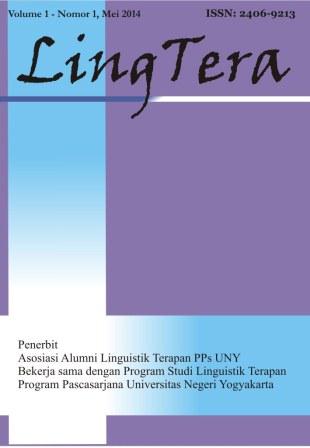TEXTUAL FUNCTION VARIATIONS OF FOREIGN EMBASSIES' PRESS RELEASES AND THEIR IMPLICATIONS FOR TRANSLATION TEACHING
DOI:
https://doi.org/10.21831/lt.v3i2.11111Keywords:
press release, textual function, translatics, translation, TSC, SFL, variationsAbstract
References
Butt, D., Fahey, R., Feez, S., et al. (2003). Using functional grammar: An explorer's guide. Sydney: Macquire University.
Denzin, N.K. & Lincoln, Y.S. (1999). Handbook of qualitative research. (Translated by Dariyanto, et al). Yogyakarta: Pustaka Pelajar.
Eggins, S. (1994). An introduction to systemic functional linguistics. London: Printer Publishers Ltd.
Halliday, M.A.K. (1994). An introduction to functional grammar (2rd Ed.). London: Arnold.
Halliday, M.A.K., & Matthiessen, C. (2004). An introduction to functional grammar (3rd Ed.). London: Arnold.
Moleong, L.J. (2005). Metodelogi penelitian kualitatif (edisi revisi). Bandung: PT. Remaja Rosdakarya.
Munday, J. (2008). Introducing translation studies. New York: Routledge.
Sinar, T.S.. (2007). Phasal and experiential realizations of lecture discourse: A systemic-functional analysis. Medan: Kopertis Wilayah I Sumut-NAD.
Tou, A.B. (2004). "Towards translatics: A framework of translational semiotic communication", in Jurnal Kajian Linguistik: Jurnal Ilmiah Ilmu Bahasa Universitas Sumatera Utara. Vol: 1. No: 1. Retrieved on 29 September 2012, from http://linguistik.usu.ac.id/kajian-linguistik-jurnal-ilmiah-ilmu-bahasa/67-jurnal-tahun-2004-no-1.html.
Wiersma, W. (1995). Research methods in education: An introduction (6th ed.). Boston: Allyn and Bacon
Downloads
Published
How to Cite
Issue
Section
Citation Check
License
LingTera allows readers to read, download, copy, distribute, print, search, or link to its articles' full texts and allows readers to use them for any other lawful purpose. The journal allows the author(s) to hold the copyright without restrictions. Finally, the journal allows the author(s) to retain publishing rights without restrictions.
- Authors are allowed to archive their submitted articles in an open-access repository.
- Authors are allowed to archive the final published article in an open-access repository with an acknowledgment of its initial publication in this journal.

Psychology, Evaluation, and Technology in Educational Research is licensed under a Creative Commons Attribution-ShareAlike 4.0 International License.
Based on a work at https://petier.org/index.php/PETIER.










